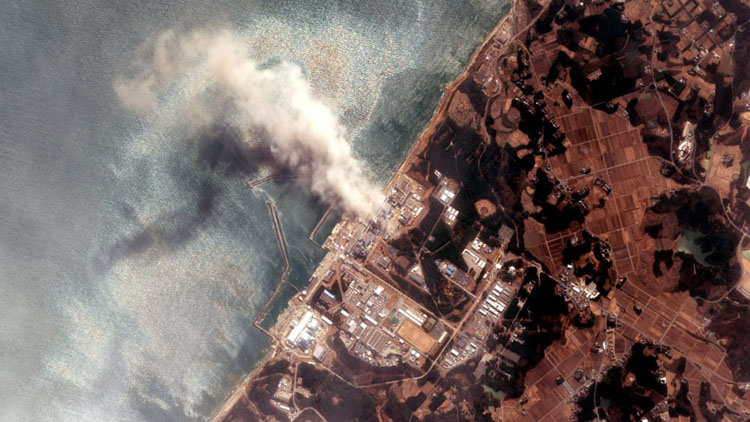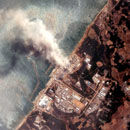 |
|---|
| In this satellite view, the Fukushima Dai-ichi Nuclear Power plant after a massive earthquake and subsequent tsunami on March 14, 2011 in Futaba, Japan. |
 
|
Vulnerable to both terrorists and Mother Nature, Japan's nuclear power plants are accidents waiting to happen
Daily Beast
Mon April 19, 2021
The man who predicted the world’s worst nuclear disaster since Chernobyl sees another one looming.
“There is a very strong possibility that there will be another nuclear disaster in Japan, and the company running the biggest nuclear plant here cannot be trusted,” Toshio Kimura, a nuclear engineer who predicted Japan’s 2011 nuclear disaster six years before it happened, told The Daily Beast.
The company he is referring to is his former employer, the Tokyo Electric Power Company Holdings (TEPCO), which operated the Fukushima plant that suffered a historic nuclear meltdown in March 2011 after a huge offshore earthquake triggered a tsunami that flooded its reactors, releasing deadly radiation and forcing 160,000 people to evacuate.
A year after the incident, an investigation by a Japanese parliamentary panel concluded that, “although triggered by these cataclysmic events,” the disaster was “profoundly manmade,” and can be attributed to “a multitude of errors and willful negligence that left the Fukushima plant unprepared for the events.”
Last week, Japan’s Nuclear Regulation Authority (NRA) effectively banned TEPCO from restarting its Kashiwazaki plant—which is one of the largest nuclear power facilities in the world—on the Sea of Japan coast after the complex was found to be riddled with major security flaws that could make it a target for terrorists.
Inspectors found 16 locations in which unauthorized entry was possible at the plant—and an attempted cover-up to boot. While the utility company had reported some of their defective equipment to the government, they had lied about the back-up systems that were supposed to correct the problem.
“It’s just another example of this company, covering up misdeeds, as they always do. It can only be said that [TEPCO] is not qualified in any way to be running a nuclear power plant,” said Kimura.
In 2005, after retiring from the company, Kimura wrote in an article that “if the [Fukushima] plant is hit by a tsunami, the pumps are to use sea water as a coolant and emergency power will probably be lost. And as a result, there will be a meltdown of the reactor core.” His prediction came true in 2011.
In Kimura’s new book How Nuclear Energy Will Destroy The Nation, he points out that TEPCO’s persistent cover-ups have resulted in nuclear safety regulations that are fundamentally flawed. Now, it’s clear that Japan’s nuclear authority agrees with him.
After obtaining preliminary approval to open certain units, the utility company had hoped to restart the Fukushima nuclear plant as early as this year. But the announcement last week has served as a de facto order to suspend operations until “the company reaches a state where self-sustained improvement can be expected” the NRA said. Restarting would have increased the company’s earnings by an estimated $950 million a year.
In a press conference regarding the TEPCO plant earlier this year, NRA Chairman Toyoshi Fuketa, while discussing the company’s failure to take effective alternative measures to deal with security issues, launched into an angry tirade: “Was it dishonesty?” he said. “Did they realize the problem and do nothing? Is there a problem with their technological prowess? Are they just fucking with us?”
Although authorities have finally derailed TEPCO’s immediate nuclear plans, experts say that Japan’s nuclear hazards are far from fixed.
“TEPCO has lied and falsified crucial safety data for as long as it has operated nuclear plants. A year or so delay is a slap on the wrist for a company that has misled regulators and systematically shortchanged safety,” Jeff Kingston, a professor at Tokyo’s Temple University who has researched Japan’s nuclear crisis for over a decade, told The Daily Beast.
“It will gain approval once it avoids shooting itself in the foot,” he added.
The Kashiwazaki plant has become a symbol of TEPCO’s ineptness and the dangers of nuclear power in an island country where earthquakes are frequent. Japan is located in the “Ring of Fire,”—a region around much of the rim of the Pacific Ocean, where volcanic eruptions and frequent earthquakes are frequent. Building nuclear reactors in Japan is a bit like building wind-turbines made out of razor blades and rotting wood in the U.S.’s tornado alley. Just not the best place to do it.
But today, there are still four operating nuclear reactors in four Japanese prefectures—two in Fukui, one in Saga, and one in Kagoshima—and all of them are plagued with safety issues like malfunctioning coolant pumps, steam leaks, and inadequate anti-terrorism measures.
The Kansai Electric Power Company (KEPCO), which operates two of the nuclear power plants, is at the center of a corruption scandal involving massive bribes and pay-offs to and from a city official over three decades. Late last year, the Osaka District Court ruled that two reactors at its Oi nuclear plant in Fukui were vulnerable to a major earthquake despite having been approved to restart by the NRA. Last year, KEPCO’s Takahama plant had to suspend operations at two nuclear reactors after failing to build adequate counterterrorism facilities.
The Genkai Power plant in Saga, operated by Ky?sh? Electric Power Company, has also suffered a host of problems since it was reactivated in March of 2018, including steam leaks and malfunctioning cooling pumps. Last month, a local district court rejected a lawsuit by residents to halt production, ruling that the plant was sufficiently safe from volcanic and seismic activity under the new guidelines.
Japan’s nuclear power plants have long been notorious for poor security, and were often supplied manpower by organized crime groups before and after the Fukushima nuclear accident. Even now, background checks are not mandatory. The situation is so dire that two former prime ministers from rival parties held a joint press conference in March of this year calling for Japan to abandon nuclear power. Most Japanese citizens seem to share their vision, with 53 percent opposed to restarting the country’s nuclear reactors.
But this is no longer Japan's problem alone. Last week, the government announced that within two years, Japan is going to release radioactive waste that is still overflowing from its 2011 nuclear accident into the ocean. Although officials have offered assurances that the water will be safe, they failed to mention that much of the ‘treated water’ on site contains lethal levels of other radioactive materials.
What happens to the people of Japan and to the countries that share their ocean when the next nuclear accident happens? It may only be an earthquake away, and neither TEPCO nor the government that should be regulating them have a promising track record when it comes to managing nuclear energy.
Ten years after the Fukushima incident, TEPCO is still cleaning up the disaster and pouring tons of seawater every day into the remains of the reactors to cool them down. It will take decades to decommission the plant, all the while remaining a disaster waiting to happen.
Japan’s aging nuclear power plants are time bombs waiting to go off. Even if terrorists don’t stumble through lax security and steal materials for a dirty bomb, Mother Nature and entropy may get the job done in their place.


 Share your thoughts in the Forum
Share your thoughts in the Forum
